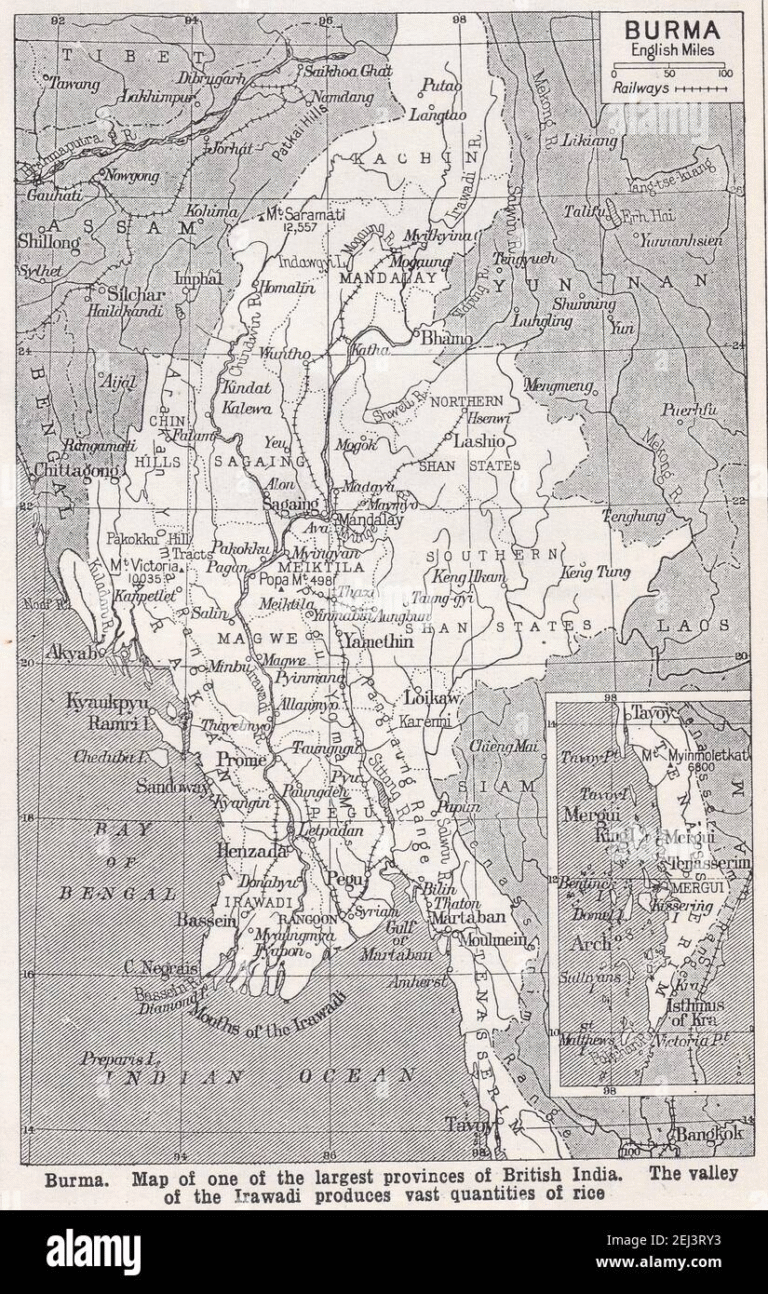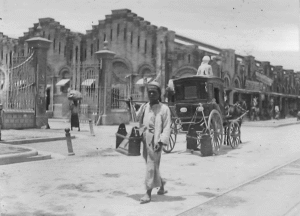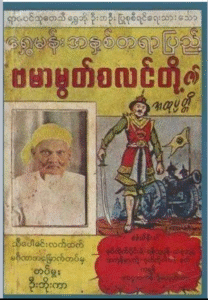Ancestral Roots: The Kaman Identity
The Kaman (or Kamein) people, a recognized ethnic group of Myanmar, are indigenous Muslims of Rakhine State, distinct from other Muslim populations in the country. The word Kaman, derived from Persian meaning “bow”, reflects their historical role as archers in the Rakhine Royal Army. During the conquest of Arakan in 1784, King Bodawpaya not only brought back the sacred Mahamuni Image to Amarapura but also relocated over 30,000 artisans and scholars, among them Kaman Muslims — stone carvers, craftsmen, royal guards, and soldiers.
Their legacy took root in Amarapura, and later Mandalay, as they served the monarchy and preserved their identity across centuries.

The Founding of Shwe Phone Shein Ward (Phayar Gyi Masjid)
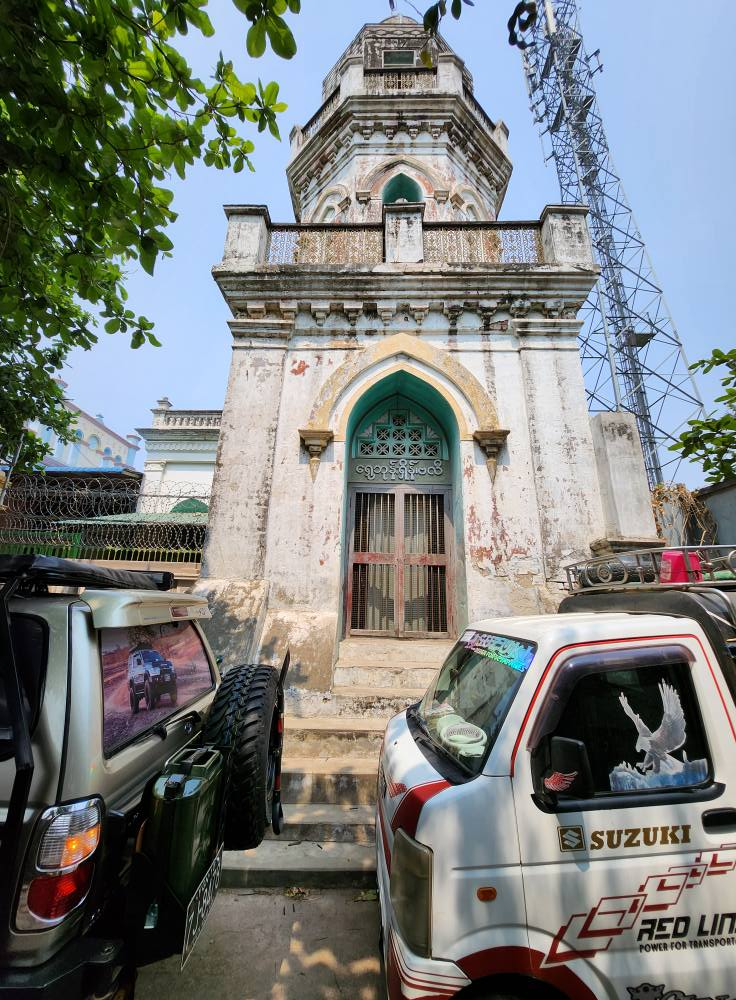
Originally stationed to serve as porters and guards of the Mahamuni Buddha Image, the Kaman were first settled near Kan Ywar (Gain Ywar). Over time, their religious devotion and royal duty earned them new land allocations.
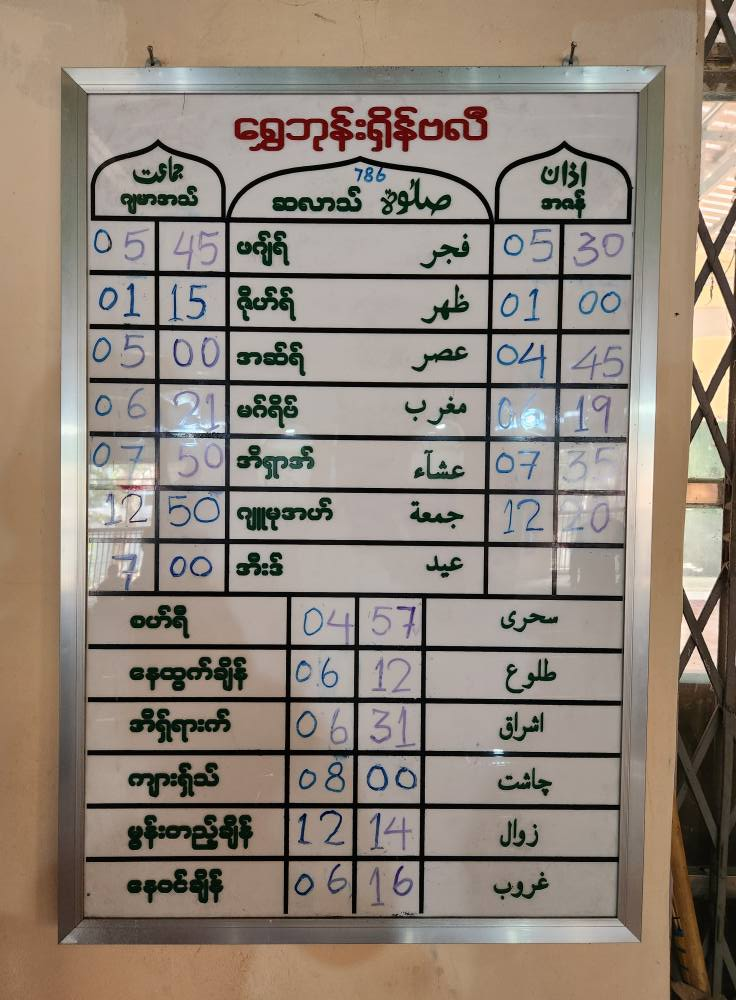
When U Shwe O, a respected Kaman leader, explained to King Bodawpaya that his community needed to pray five times daily — and were making long journeys to Amarapura to fulfill this — the king responded with both empathy and respect. He granted a plot of land just north of the Mahamuni Pagoda, in present-day Shwebohnshein Ward, to build a mosque near their post.

Thus was born the Phayar Gyi Masjid, meaning “Mosque of the Great Image,” a name bestowed by the king himself in recognition of the mosque’s proximity to the pagoda and the royal guards’ sacred duty.
This mosque predates Mandalay City itself by 74 years and stands today as one of the oldest mosques in Upper Myanmar, with a legacy that spans over 238 years.
Architectural Heritage and Centuries of Worship
The current brick structure of the mosque was completed in 1924, replacing earlier versions made of bamboo and wood. Now, as it nears its centennial anniversary, its solid colonial-era brickwork, decorative floor tiles (tarazo), and deep adjoining Wozu Lake remain testaments to the community’s historical presence.

The lake beside the mosque is believed to be the deepest among Mandalay’s mosque-adjacent lakes, at more than five cubits (approx. 7.5 feet).
During its heyday, the mosque was surrounded by a vibrant Kaman Muslim community — descendants of royal guards and artisans — many of whom continued to live around the mosque for generations, marrying within the community and returning for major religious events even after moving elsewhere.
War, Fire, Earth Quake and Reconstruction
The mosque survived two major fires during the reign of King Thibaw (1879–1884), and remarkably escaped destruction during World War II. In 1921, the current mosque’s foundation was laid, and it was completed in 1924. Its 100th anniversary is now just around the corner.
Despite these trials, the mosque endured — a symbol of faith and identity through centuries.
Displacement and Erasure (1989–1998)
After the 1988 uprising and subsequent military takeover, the Peace and Development Council issued orders in May 1989 to forcibly relocate the Kaman community from Shwebohnshein. They were moved to the newly designated Aung Pinle New Town — which in reality was just flood-prone rice fields, without roads, electricity, or water.
The resettled Kaman had to build their lives from scratch: clearing brush, digging drains, building roads, and creating a livable space.
In 1998, the authorities made a further attempt to demolish the Phayar Gyi Mosque itself. Bulldozers were mobilized under the order of Major Moe Paw (ဗိုလ်ကြီး မိုးပေါ် ), the township secretary. But thanks to the efforts of U Ba Tin {ဘုရားကြီးဗလီဂေါပကအဖွဲ့ ဥက္ကဋ္ဌ ဦးဘတင်(အေဝမ်း)}, Ko Myo Win Aung, and members of the mosque committee — and by the grace of Allah — the demolition was halted, and the mosque was spared.
Tragically, during the 1989–1990 citizenship card scrutiny, many Kaman were stripped of their ethnic designation. They were reclassified as “Bamar” by race and “Islam” by religion, erasing their Kaman identity from official records.
Today: A Call to Remember
Only a few families still remain near Phayar Gyi Masjid. The Friday congregation has thinned. Many descendants have moved away. But the mosque remains — silent, sturdy, and sacred.
This is a call to the younger generation of Myanmar Muslims, especially those of Kaman descent:
“Reclaim your heritage. Return to your roots. Remember the mosque built by your ancestors who carried the Mahamuni Image and served the kings of Myanmar with dignity and faith. Let Phayar Gyi Masjid echo once more with prayers and footsteps.”
Location: Shwebohnshein Ward, Mandalay
Established: 1784 (earliest form)
Current Structure Completed: 1924
Historical Role: Royal Guard Mosque of Mahamuni Pagoda
Ethnic Community: Kaman Muslims (indigenous Burmese citizens)
With gratitude to:
- Maung Maung (Shwe Karawik)
- MM Dialogue Members
- Haji Htet Naung Oo (Prince)
- Ko Myat Min (Photo documentation)
- All who have preserved this memory for future generations
မန္တလေးမြို့မှာ ကမန်အမျိုးအနွယ် အစုအဝေးကြီး တခုလုံးအတင်းအကြပ် ပြောင်းရွှေ့ခံခဲ့ရ
မောင်မောင်(ရွှေကရဝိက်) ရေးသည်။
ကိုအပုချေ ရေးထားတဲ့ ကမန်တွေ အတင်းအကြပ် ပြောင်းရွှေ့ခံကြရ တဲ့အကြောင်း ဖတ်မိတော့….
ကျနော်တို့ မန္တလေးမြို့မှာ ကမန်အမျိုးအနွယ် အစုအဝေးကြီး တခုလုံးအတင်းအကြပ် ပြောင်းရွှေ့ခံခဲ့ရပုံ ကို သတိရမိတယ်
ဟုတ်ပါတယ် ကျနော်တို့ မန္တလေးမြို့မှာ ကမန်အမျိုးသားတွေ နေထိုင်ကြတဲ့ ရပ်ကွက် ကြီးတခု ရှိခဲ့ပါတယ်
မဟာမြတ်မုနိ (ဘုရားကြီး) အနီးက ရွှေဘုန်းရှိန် ရပ်ကွက် အတွင်းမှာဖြစ်ပါတယ်
တကယ်တန်း ပြောကြမယ်ဆိုရင် ရွှေဘုန်းရှိန်ရပ်ကွက်ဟာ မန္တလေးမြို့မတည်ဆောက်မှီကထဲက တည်ရှိခဲ့တဲ့ရပ်ကွက်ပါ
အမရပူရမြို့တည် နန်းတည် ဘိုးတော်ဦးဝိုင်းလက်ထက်က ရခိုင်ကိုအောင်နိုင်လိုက်တော့ ကနောင်မင်းသားက ရခိုင်ကနေ မဟာမြတ်မုနိရုပ်ပွားတော်ကို ပင့်ဆောင်လာတော့ ကမန်လူမျိုးတွေကို ပေါ်တာ အဖြစ် အသုံးပြု သယ်ဆောင်စေခဲ့ပါတယ်
(အဆိုအချို့အရ -ပေါ်တာတွေရဲ့ လက်ဖဝါးတွေကို ဖေါက်ပြီး ကြိုးနဲ့သီပြီး ရုပ်ပွားတော်ကြီးပင့်ဆောင်တဲ့လမ်းခရီးမှာ ထွက်မပြေးနိုင်အောင်လုပ်ခဲ့တယ်လို့ ဆိုပါတယ်)
အဲ့ဒီ ပေါ်တာဆွဲခေါ်လာတဲ့ ကမန်တွေကို မဟာမြတ်မုနိဘုရားကြီးရဲ့တောင်ဖက် ကံရွာ(ဂိုင်ရွာ) မှာနေရာချထားပေးခဲ့ပါတယ်
ကံရွာ က ဘုရားကြီးရဲ့ တောင်ဖက်မှာရှိပါတယ်–
အဲ့ဒီနောက် ဘုရားကြီး(မဟာမြတ်မုနိရုပ်ပွားတော်)က ရွှေများ မကြာခနအခိုးခံရတဲ့အတွက်ကမန်လေးသည်တော်များကို အစောင့်အဖြစ် ခန့်ထားပြီး ဘုရားကြီရဲ့အနောက်မြောက်ဖက် ရွှေဘုန်းရှိန် ရပ်ကွက် မှာ နေရာချထားပေးခဲ့
ပါတယ်
မဟာမြတ်မုနိကို ထိန်သိမ်းစောင့်ရှောက်ရတဲ့ ကမန်လေးသည်တော်တွေဟာ အစ္စလာမ်ဘာသာဝင်တွေဖြစ်တဲ့အတွက် နေ့စဉ် ငါးကြိမ် ဝတ်ပြုဖို့အတွက်ရွှေဘုန်းရှိန် ရပ်ကွက်ကနေ ၃-၄ မိုင်ခန့်အဝေးမှာရှိတဲ့ အမရပူရ ကိုယ်ရံတော် ဗလီကို သွားရောက်ခဲ့ကြရပါတယ်
အဝေးရှိ ဗလီကို သွားရောက်ဝတ်ပြုရတဲ့အတွက် ဘုရားကြီးကို ထိန်းသိမ်းကာကွယ်စောင့်ရှောက်ရာမှာ လစ်ဟင်းမှုရှိမှာကို စိုးရိမ်တဲ့ ဘိုးတော်ဦးဝိုင်းက ရွှေဘုန်းရှိန် ရပ်ကွက်အတွင်းမှာ ဗလီမြေနေရာတခုသတ်မှတ်ပေးပြီးဝတ်ပြုစေခဲ့ပါတယ်
အဲ့ဒီ ဗလီကို ဘုရားကြီးဗလီ လို့ပဲ ခေါ်ဝေါ်ကြပါတယ်နောက်ပိုင်းမှသာ ရွှေဘုန်းရှိန်ဗလီလို့ ခေါ်ဝေါ်လာကြတာ ဖြစ်ပါတယ်
ဘုရားကြီးဗလီ ရွှေဘုန်းရှိန်ရပ်ကွက်မှာနေထိုင်တဲ့ ကမန်အဆက်အနွယ်တွေဟာ မန္တလေးက အခြားမွတ်စလင် အသိုင်းအဝိုင်းနဲ့ ပုံစံမတူပဲမြန်မာဆန်ဆန် သီးခြားနေထိုင်ကြသူများဖြစ်ကြပါတယ်
အိမ်ထောင်ပြုကြရာမှာလည်း(များသော အားဖြင့်) သူတို့ ဘုရားကြီး အသိုင်းအဝိုင်းအတွင်းက လူအချင်ချင်းသာ ပြုတတ်ကြပါတယ်
မြို့ရဲ့အခြားနေရာတွေ အခြားမြို့တွေမှာ အခြေချဖြစ်သွားတဲ့ ဘုရားကြီးသားတွေဟာ အလှူအတန်းပြုတဲ့အခါ အခါကြီး ရက်ကြီးတွေကို သူတို့ဇာတိ ဘုရားကြီးဗလီကိုသာ ဆုံရပ်အဖြစ် ပြန်လာလေ့ရှိကြပါတယ်
၁၉၈၈ အရေးအခင်းကာလကြီးမှာ ဘုရားကြီးက ကမန်မွတ်စလင်မိသားစု တွေဟာ အခြားမွတ်စလင်များနည်းတူ အစ္စလာမ့်သမဂ္ဂမှာ ပူပေါင်းပါဝင်ခဲ့ကြပါတယ်
၁၉၈၈ စက်တင်ဘာလ စစ်တပ်ကအာဏာသိမ်းပြီးတဲ့နောက်၁၉၈၉ ခုနှစ် မေလ မှာတော့ မြို့နယ်ငြိမ်ဝပ်ပိပြားမှုတည်ဆောက်ရေးအဖွဲ့ အမိန့်နဲ့ ဘုရားကြီး ဗလီပိုင်မြေကွက်ပေါ်မှာ နေထိုင်တဲ့ ကမန်လူမျိုးများကို အောင်ပင်လယ်မြို့သစ်ကို မဖြစ်မနေ ပြောင်းရွှေ့ နေရာချ ပစ်ခဲ့ပါတယ်
အောင်ပင်လယ်မြို့သစ် ဆိုတာ အခေါ်အဝေါ် ပဲ ရှိပါတယ် တကယ်တော့ အောင်ပင်လယ် ကန်ကြီးထဲက လယ်ကွက်တွေကိုအကွက်ရိုက်ပြီး ရေမရှိ လျှပ်စစ်မီးမရှိ လမ်းမခင်းရသေးတဲ့ မြွေတောဖားတော ရွှံ့ညွန်တောထဲမှာ ပို့ထားခဲ့တာပါ
နောက်ပိုင်းမှ ကိုယ်ထူ ကိုယ်ထ မြေဖို့/လမ်းခင်း/မြှောင်းဖေါက်/မြွေရှင်း/ရေရအောင်စီမံ /မီးရရှိရေးလုပ် နဲ့ မြို့ဖြစ်အောင် တည်ဆောက်ယူခဲ့ကြရတာပါ
ဘုရားကြီးဗလီပတ်ဝန်းကျင်မှာတော့ ကိုယ်ပိုင်မြေ ကိုယ်ပိုင်အိမ်နဲ့ နေထိုင်သူ မိသားစု ဦးရေ ဆယ်ဂဏန်းလောက်သာ ကျန်ခဲ့ပါတော့တယ်
အဲ့ဒီအချိန် ၁၉၉၈ ဧပြီလအတွင်းမှာ မြို့နယ်ငြိမ်ဝပ်ပိပြားမှုတည်ဆောက်ရေးအဖွဲ အတွင်းရေးမှူး ဗိုလ်ကြီးမိုးပေါ်ဦးဆောင်ပြီး ဘုရားကြီးဗလီကိုဘူလ်ဒိုဇာထိုး ဖျက်ဆီးသိမ်းယူဖို့ ကျိုးစားခဲ့ပါသေးတယ်
ဘုရားကြီးဗလီဂေါပကအဖွဲ့ ဥက္ကဋ္ဌ ဦးဘတင်(အေဝမ်း)မှ အစ္စလာမ်ဘာသာရေးအဖွဲ့များကို အကူအညီ တောင်းခံခဲ့ပေမဲ့မန္တလေးမြို့ မွတ်စလင်လူထုနဲ့ ကင်းကွာပြီး သီးခြားနေထိုင်ခဲ့ကြသူတွေ ဖြစ်လို့ ထင်ပါရဲ့
ဘယ်အဖွဲ့အစည်းကမှ ကူညီ ဖြေရှင်းပေးမှု မလုပ်ခဲ့ကြပါဘူးမကူညီကြပါဘူး
ဒါပေမဲ့ ဦးဘတင်ရဲ့ ဦးဆောင်မှုနဲ့ ကိုမျိုးဝင်းအောင် နဲ့ ကျနော် တို့ရဲ့ကျိုးစားမှု အပေါ် အလ္လာဟ်အရှင် အလိုတော်တူမှုကြောင့်ဗိုလ်ကြီး မိုးပေါ် လက်လျှော့ သွားခဲ့ပါတယ်ဘုရားကြီးဗလီလည်း နှောက်ယှက်ဖျက်ဆီးလိုသူများရန်က လွတ်မြောက်ခဲ့ပါတယ်
အောင်ပင်လယ် မြို့သစ်ရောက် ကမန်အမျိုးအနွယ်တွေကတော့၁၉၈၉/၉၀ နိုင်ငံသားစီစစ်ရေးကဒ်မှာ လူမျိုး-ဗမာ ကိုးကယ်သည့်ဘာသာ-အစ္စလာမ်နဲ့ ကမန်အမည် အဖျောက်ခံရပြီးတဲနောက်ဒီနောက်ပိုင်းမှာတော့ ဘင်္ဂါလီ-ဗမာ လူမျိုးတွေ ဖြစ်ကုန်ကြမှာ သေခြာပါတယ်
မန္တလေးက ကမန်အမျိုးအနွယ် တွေ အတင်းအဓမ္မ ပြောင်းရွှေ့ နေရာအချထားခံရတာကို သတိရလို့ တင်ပြလိုက်ရပါတယ်
မောင်မောင်(ရွှေကရဝိက်)
Htet Naung Oo
” အမရပူရရောက်ရခိုင် ကမန်မွတ်စလင်များနဲ့ ရွှေဘုန်းရှိန်ဗလီ “
ဒီနေ့ မဂရိဘ်နမားဇ်ကိုရွှေဘုန်းရှိန်ဗလီ မှာ သွားပြီးဝတ်ပြုဖြစ်ခဲ့တာ ဝိုဇူရေကန်ဘေးမှာ ခင်းထားတဲ့ တာရာဇိုတွေက အရင် မန္တလေးစျေးချို ၁၂ ရုံမှာ ခင်းထားခဲ့တဲ့ တာရာဇိုတွေ အတိုင်း မပျက်မစီးအကောင်းပကတိ တွေ့ခဲ့ရတယ်
အုတ်နဖူးစည်းမှာထိုးထားတဲ့ ခုနှစ်ကို ကြည့်လိုက်တော့ ၁၉၂၄ ဆိုတော့ နှစ်တစ်ရာပြည့်ဖို့ ၁ နှစ်ပဲလိုတော့တယ်
ဗလီကြီးကလဲ အုတ်ထုထည်ကောင်းကောင်းနဲ့ ဆောက်ထားခဲ့လို့ အခုထိခန့်ထည်စွာနဲ့ရှိနေပြီး လက်ရာကကိုလိုနီခေတ်လက်ရာတွေပါ
ဝိုဇူရေကန်ရဲ့အနက်က မန္တလေးပတ်ဝန်းကျင်မှာ ရှိတဲ့ ဗလီဝိုဇူရေကန်တွေထဲမှာ အနက်ဆုံးဖြစ်မယ်ထင်ပါတယ် အနက် ၅ ပေကျော်လောက်ရှိပါတယ်
ရွှေဘုန်းရှိန်ဗလီကြီးက မန္တလေးမြို့သက်ထက် ၇၄ နှစ်စောပြီး ရှိနေခဲ့လို့ အခုဆိုရင် ၂၃၈ နှစ်သက်တမ်းရှိနေခဲ့ပါပြီ
ဗလီရဲ့သမိုင်းရာဇဝင်က
၁၇၈၄ ခုနှစ်မှာ ဘိုးတော်ဗဒုံမင်းက သူ့ရဲ့သားတော် အိမ်ရှေ့စံရွှေတောင်မင်းကို ဓညဝတီရခိုင်ပြည်ကို သွားရောက်သိမ်းယူစေခဲ့ရာက မဟာမုနိရုပ်ရှင်တော် နဲ့ တကွ ရခိုင်ပညာရှင် သုံ့ပန်း သုံးသောင်းကျော်ကို အမရပူရနေပြည်တော်သို့ ခေါ်ဆောင်လာခဲ့ရာ ကမန် အစ္စလာမ်ဘာသာဝင်လေးသည်တော် ပန်းပုပညာရှင် ကျောက်ဆစ်ပညာရှင် တစ်ထောင်ကျော်လဲ ပါလာခဲ့ကြပါတယ်
အမရပူရနေပြည်တော်ရဲ့ မြောက်ဘက် အခု မန္တလေး မတည်ရသေးတဲ့နေရာမှာ ဘုရားကြီးကို တည်ထားခဲ့ပါတယ်
အစ္စလာမ်ဘာသာဝင် ပန်းပုပညာရှင်များနဲ့ လေးသည်တော်များကိုလဲ ဘုရားနဲ့အနီးတဝိုက်မှာ နေရာချပြီးနေစေခဲ့ပါတယ်
ဘုရားကြီးဆောက်လုပ်နေစဥ် ဘိုးတော်ဘုရားက လာရောက်ကြည့်ရှု့ရာ ကမန်တပ်မှူးဦးရွှေအိုးအား မတွေ့သဖြင့် မေးမြန်းရာမှ ဦးရွှေအိုး ပြန်ရောက်လာ၍ မိမိတို့ ဘာသာဝင်များ အနေဖြင့် နေ့စဥ် တနေ့ ငါးကြိမ် ဝတ်ပြုရကြောင်း ဝတ်ပြုသောအခါ အမျိုးသားများမှာ ဝတ်ကျောင်းတော်များတွင် လည်းကောင်း အမျိုးသမီးများမှာ မိမိတို့နေအိမ်များတွင်လည်းကောင်းဝတ်ပြုရသဖြင့် အမရပူရဘက်သို့သွားရောက်ဝတ်ပြုနေကြောင်း သံတော်ဦးတင်လျှောက်ထားခဲ့ပါတယ်
ဘိုးတော်ဘုရားကလဲ ဝတ်ပြုရာတွင် နှောင့်နှေးကြန့်ကြာမှု့မဖြစ်စေရန် ဘုရားကြီး၏မြောက်ဘက် မြင်းဝန်မင်းကြီးတိုက်၏တောင်ဘက် သင့်မြတ်ကောင်းမွန်သောနေရာတွင် ဝတ်ပြုကျောင်းဆောင်ဆောက်လုပ်ခွင့်ပြုခဲ့ပါတယ်
ဦးရွှေအိုး နှင့် အမှု့ထမ်းများ အား ရွေးချယ်၍မဟာမုနိဘုရားကြီး၏ ရွှေတံခါးသော့ကိုင် ရာထူးဂုဏ်ထူးများပေးအပ်ခဲ့ပါတယ်
ဘုန်းရှိန်ဝါ ကြီးမြတ်တဲ့သူတွေအတွက် ဝတ်ပြုရာနေရာဖြစ်လို့ ရွှေဘုန်းရှိန်ဗလီ အမည်နာမဘွဲ့တော်ကို ဘုရင်ကိုယ်တိုင် ချီးမြှင့်ပေးခဲ့တာပါ
ဘုရားကြီးစောင်းတန်းများမှာလဲ ထီးခရိုင်ကုန်သည်များနံ့သာဖြူကုန်သည်များ အမွှေးတိုင်ကုန်သည်များအဖြစ် ဘုရင်အဆက်ဆက် အသိအမှတ်ပြုခဲ့၍ ရောင်းဝယ်ဖောက်ကားခဲ့ကြပါတယ်
ပထမဆောက်လုပ်ခဲ့သော ဝတ်ကျောင်းတော်မှာ ဝါးဗလီဝတ်ကျောင်းတော်ဖြစ်ခဲ့ပါတယ်
ရွှေဘုန်းရှိန်ဗလီ နှင့်အတူ တည်ခဲ့သော ဗလီများမှာ
ကံရွာဗလီ
သိုးခြံရွာဗလီ
တောင်မြင့်ဗလီ
ဝေသာလီဗလီများ ဖြစ်ခဲ့တယ်လို့ မှတ်တမ်းများမှာ တွေ့ရပါတယ်
( ဝေသာလီဗလီ မှာ ယခုမရှိတော့ )
မဟာမုနိဘုရားကြီး နဲ့ ရွှေဘုန်းရှိန်ဗလီ တို့ကနေ မြောက်ဘက် ကို ဆက်သွားရင် အမရပူရမြောက်ပြင်သုသာန်ကို ရောက်ပါတယ် ( အခု အ.ထ.က ၁၃ ကျောင်း နေရာတဝိုက် )
မင်းတုန်းမင်းလက်ထက် မန္တလေးမြို့တည်ပြီးတဲ့အခါ မန္တလေးမြို့ နယ်နိမိတ်ထဲကို ရောက်ရှိခဲ့ပြီးသီပေါမင်း လက်ထက်
၁၈၇၉ နဲ့ ၁၈၈၄ တို့မှာမဟာမုနိဘုရားကြီးနဲ့အတူ မီး ၂ ကြိမ် သင့်ခဲ့ပါတယ်
၁၈၈၅ မှာ ကျွန်းပျဥ်ထောင်ဗလီအဖြစ်ဆောက်ခဲ့ရာမှနှစ်ကာလကြာမြင့်လာပြီး ပျက်စီးယိုယွင်းခဲ့လို့
၁၉၂၁ မှာ အခုလက်ရှိ အုတ်ဗလီကြီးကို စတင်အုတ်မြစ်ချ တည်ဆောက်ခဲ့ကြရာ
၁၉၂၄ မှာ အလုံးစုံပြီးစီးခဲ့ပါတယ်
၁၉၄၂ ဒုတိယကမ္ဘာစစ်မီးက ကင်းလွတ်ခဲ့၍ နှစ်ပေါင်း ၉၉ နှစ် ထုထည်ခိုင်မာစွာနဲ့ ရှိနေခဲ့ပြီး
အခုနောက်ပိုင်း ဂျမာအတ်အင်အားနည်းပါးလာတာကိုလဲ ဝမ်းနည်းစွာတွေ့ရမြင်ရပါတယ်
ဗလီကြီးရဲ့ အရှေ့ဘက်မှာကမန်လေးသည်တော်တို့ရဲ့မျိုးဆက်တွေ အစဥ်အဆက်နေထိုင်ခဲ့ကြပြီး
လွန်ခဲ့တဲ့ နှစ်ပေါင်း ၃၀ ကျော်လောက်က ဖယ်ရှားခံခဲ့ရပါတယ်
ရှေးမြန်မာမွတ်စလင် တွေ နှစ်ပေါင်းရာနဲ့ချီပြီး မျိုးစေ့ချပေးခဲ့လို့ဝတ်ပြုခဲ့ကြတဲ့ရှေးဗလီကြီးကို သွားရောက်ဝတ်ပြုသင့်ပါတယ်
ဟာဂျီထက်နောင်ဦး
( Prince)
Photo Credit. Ko Myat Min
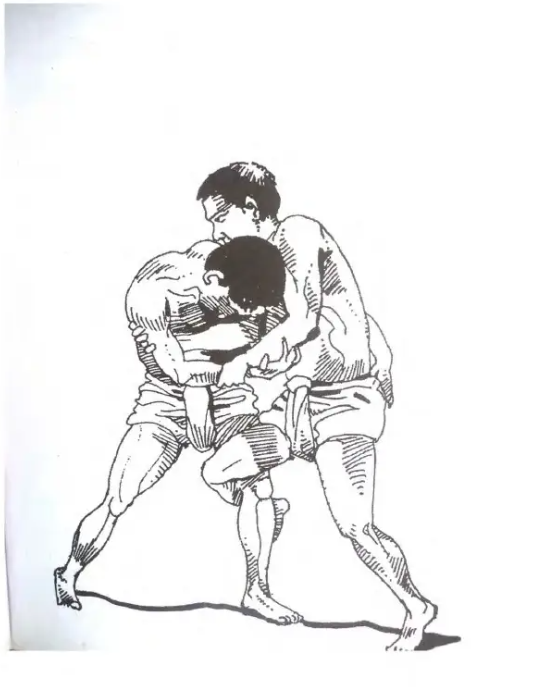
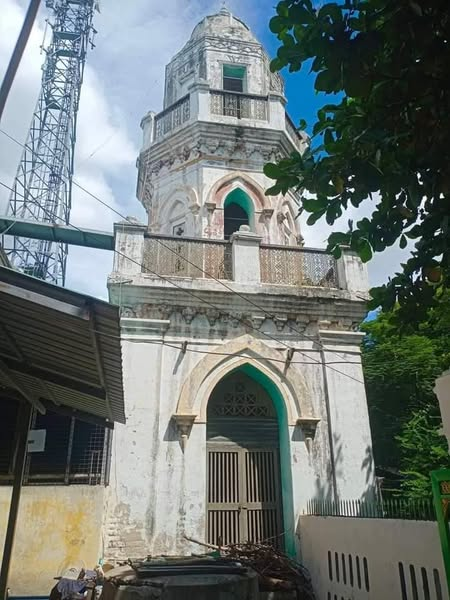



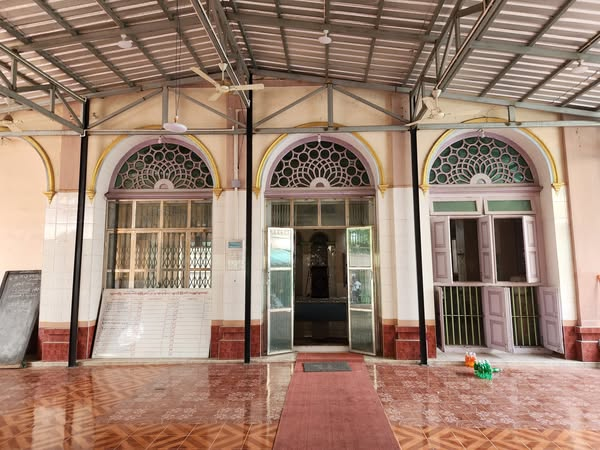
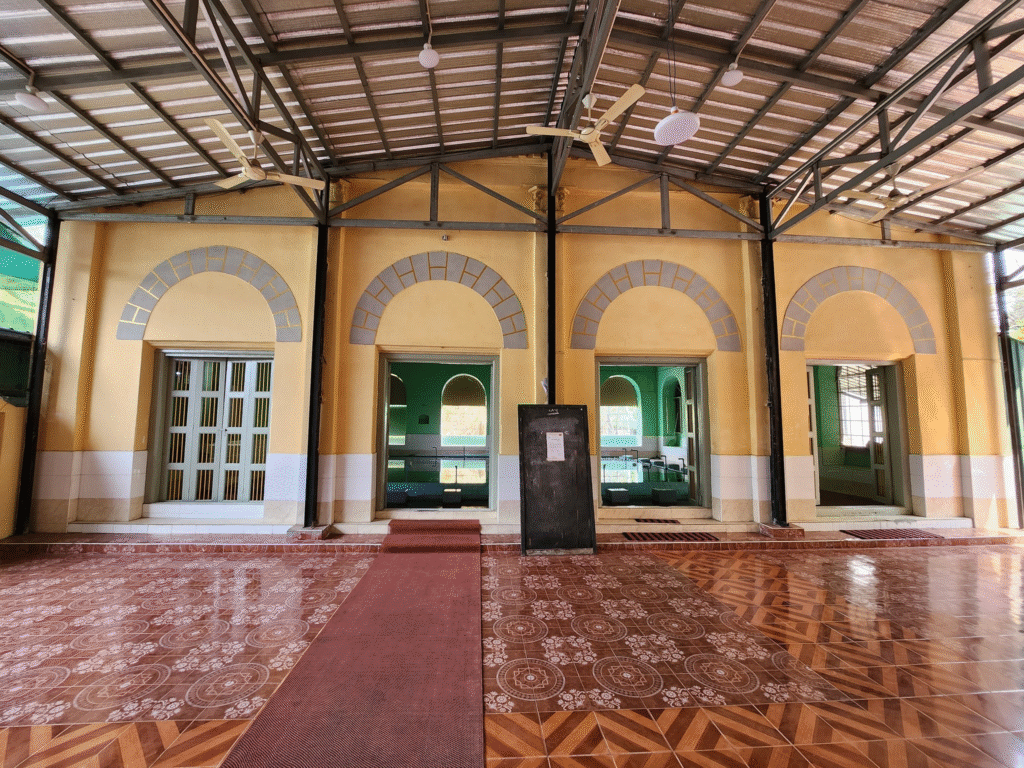













Could read the scanned book in my Outstanding Muslims from Myanmar @



